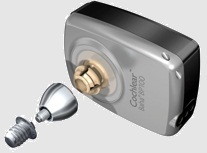
 A BAHA (Bone Anchored Hearing Aid) is an auditory implant and sound processor. The Baha is a surgically implantable system for treatment of hearing loss that works through direct bone conduction. It has been used since 1977,it is as a treatment for conductive and mixed hearing losses.
A BAHA (Bone Anchored Hearing Aid) is an auditory implant and sound processor. The Baha is a surgically implantable system for treatment of hearing loss that works through direct bone conduction. It has been used since 1977,it is as a treatment for conductive and mixed hearing losses.
Baha is used to help people with chronic ear infections, congenital external auditory canal atresia and single sided deafness who cannot benefit from conventional hearing aids. The system is surgically implanted and allows sound to be conducted through the bone rather than via the middle ear – a process known as direct bone conduction.
 BAHA is a treatment option for people with moderate to severe hearing loss who don’t benefit from normal (air conduction) hearing aids. The commonest reasons for considering BAHA are
BAHA is a treatment option for people with moderate to severe hearing loss who don’t benefit from normal (air conduction) hearing aids. The commonest reasons for considering BAHA are
 The Baha consists of three parts:
The Baha consists of three parts:
The system works by enhancing natural bone transmission as a pathway for sound to travel to the inner ear, bypassing the external auditory canal and middle ear. The titanium implant is placed during a short surgical procedure and over time naturally integrates with the skull bone.
For hearing, the sound processor transmits sound vibrations through the external abutment to the titanium implant. The vibrating implant sets up vibrations within the skull and inner ear that finally stimulate the nerve fibers of the inner ear, allowing hearing.